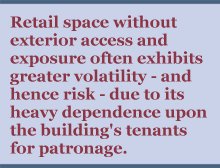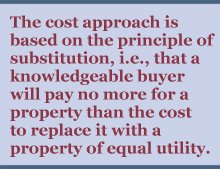

|
207 Abbey Lane Lansdale, Pennsylvania 19446 215-855-1800 |
5201 Ocean Avenue #2007 Wildwood, New Jersey 08260 215-990-6663 |
Specializing in Real Estate Appraisal and Property Tax Consulting
A Professional Courtesy of:
|

Specializing in Real Estate Appraisal and Property Tax Consulting |
| Winter 2007 |
 |
|
In This Issue: |
|
New Urbanism: A Growing Trend Over the past 20-25 years, an alternative to traditional suburban development has emerged. The concept is known by various names, including new urbanism, neo-traditional design, transit-oriented development and traditional neighborhood development.Regardless of the moniker, new urbanism generally reflects specific elements such as Examples of the concept, are long-established areas such as downtown Charleston, South Carolina; Old Town Alexandria, Virginia; and Georgetown in Washington, D.C. According to Wikipedia, there are more than 600 new towns, villages and neighborhoods planned or under construction that reflect the essence of new urbanism. Furthermore, there are hundreds of small-scale new urbanism developments in infill locations in many cities throughout the United States. As with any new developmental concept, lenders were initially reluctant to provide financing for such development. This reluctance has been ameliorated by market acceptance.  The primary concerns of lenders for such development are the strength of the project's sponsorship and the scale of the development, particularly the forecast period needed for completion and absorption. Both are important in that the absorption of large-scale developments may well extend across the various phases of the economic/real estate cycle. If so, the experience and financial stability of the developer become extremely significant elements of success.
The primary concerns of lenders for such development are the strength of the project's sponsorship and the scale of the development, particularly the forecast period needed for completion and absorption. Both are important in that the absorption of large-scale developments may well extend across the various phases of the economic/real estate cycle. If so, the experience and financial stability of the developer become extremely significant elements of success.The Urban Land Institute published a study of new urbanism approximately six years ago. The focus of the study was on single-family residences. The price differential in costs between homes within new urban ism developments and those in traditional subdivisions was in the range of $5,000-$30,000. The study also indicated that a surprisingly large number of home buyers were willing to pay such a premium to live in a new urbanism development. Anecdotal evidence suggests that the market is indeed embracing the concept. The future of new urbanism appears to be quite positive. Undoubtedly, the concept will continue to evolve based upon developers' experiences and feedback from the market. |
Scope of Work: New Flexibility to Serve Clients Better Real estate appraisers are required to comply with the Uniform Standards of Professional Appraisal Practice (USPAP), as promulgated by the Appraisal Standards Board of the Appraisal Foundation and adopted by the states. USPAP initially was developed in 1986-1987 and has since gone through numerous iterations.USPAP provides ethical requirements and standards for performance of the appraisal process as well as reportage of the appraiser's findings/opinions. Compliance is not discretionary. The most recent version of the USPAP (effective July 1, 2006) has been modified significantly. Previously, the document contained numerous requirements, from which limited departure was permitted. The appraiser was thus often unable to structure the assignment to meet client's specific needs (i.e., intended use), given the client's level of understanding of the property and relative sophistication regarding real estate in general. Some clients had criticized the USPAP as being inflexible, prohibiting the professional appraiser from directly solving clients' specific problems and needs for any particular assignment.  The current version of the USPAP reflects a different perspective in that it allows for the appraiser and the client to design the assignment to address the specific client problem(s) to be solved. The previous departure mechanism was replaced by minimum standards that must be followed. The operative term describing the foregoing is "scope of work."
The current version of the USPAP reflects a different perspective in that it allows for the appraiser and the client to design the assignment to address the specific client problem(s) to be solved. The previous departure mechanism was replaced by minimum standards that must be followed. The operative term describing the foregoing is "scope of work."As cited in the USPAP, the scope of work rule states, "For each appraisal, appraisal review and appraisal consulting assignment, an appraiser must: "An appraiser must properly identify the problem to be solved in order to determine the appropriate scope of work. The appraiser must be prepared to demonstrate that the scope of work is sufficient to produce credible assignment results." A key consideration in determining scope of work is the client's intended use of the appraisal. For example, a client that intends to use the appraisal for the purpose of litigation support will likely expect a much more comprehensive scope of work than if the intended use is for preliminary analysis of a property for potential acquisition. As the USPAP states, "The scope of work ... continues to be based upon what is required to produce credible assignment results." The importance of these changes from clients' perspectives is significant. Clients will no longer be burdened by appraisal reports that are not in keeping with their needs. The scope of work should be determined by interaction between the client and the appraiser prior to commencement. During the appraisal process, the client may wish to expand or contract the scope, based upon subsequent findings by the appraiser. In short, the current version of USPAP enables the professional appraiser to better serve clients' needs, for fees that are commensurate with the scope of work. |
Other Income Sources from Office Buildings Investors in office buildings clearly focus on the potential for revenue generation from the leasing of the office space therein. However, there are often additional income sources to be considered, particularly in larger properties. The two largest sources of other income for major buildings are parking and retail income. The former emanates from on-site or nearby owned parking lots and garages. Owners of larger buildings generally choose to contract with parking facility operators rather than to operate the facility internally. If a third-party vendor is utilized, no further deduction of expenses (except perhaps a small administrative management fee) may be necessary. Care should be taken to understand the terms of any such agreement (i.e., revenue and expense sharing between the parties). The two largest sources of other income for major buildings are parking and retail income. The former emanates from on-site or nearby owned parking lots and garages. Owners of larger buildings generally choose to contract with parking facility operators rather than to operate the facility internally. If a third-party vendor is utilized, no further deduction of expenses (except perhaps a small administrative management fee) may be necessary. Care should be taken to understand the terms of any such agreement (i.e., revenue and expense sharing between the parties).Parking revenues are normally, but not always, correlated with building occupancy. There may, of course, be external demand for parking, depending on the dynamics of the market area supply and demand. The extent of free or discounted parking as an inducement for office leasing should be considered. In any event, careful analysis of historical revenue and expense for the building being appraised is crucial to the accurate estimation of future receipts (gross and net).  Many larger office buildings have a retail component, generally on the street or subgrade levels. Leases for such space are typically written with different tenant expense responsibilities (on a net basis from the lessors' perspective. Retail space without exterior access and exposure often exhibits greater volatility - and hence risk - due to its heavy dependence upon the building's tenants for patronage.
Many larger office buildings have a retail component, generally on the street or subgrade levels. Leases for such space are typically written with different tenant expense responsibilities (on a net basis from the lessors' perspective. Retail space without exterior access and exposure often exhibits greater volatility - and hence risk - due to its heavy dependence upon the building's tenants for patronage.Tenant reimbursements of expenses over the base lease year are frequently substantial. Because these reimbursements increase each year for a particular lease (assuming continued inflation of expenses), forecasts of future reimbursements should be based upon those modeled on a lease-by-lease basis in a discounted cash-flow analysis. Additional sources of other revenue include Telecommunications income typically consists of both rooftop revenue and income from telecommunications providers for wire access to the building. Telecommunications revenue is generally more volatile than the balance of the income stream, due to continuous changes in technology and the relative instability of some telecommunications companies as lessees. The sources and durability of other income should be carefully analyzed. The simplistic assumption that other income will continue in the same magnitude as in the past may very well lead to inaccurate valuation results. Professional appraisers are well trained in performing such analyses. |
The Cost Approach: Is It Relevant? Of the three approaches used to form opinions of market value, the cost approach is employed much less frequently than either income capitalization or sales comparison. This leads some to assume that the cost approach is an irrelevant measure of value. The blind acceptance of this assumption is ill-founded.The cost approach is based on the principle of substitution, i.e., that a knowledgeable buyer will pay no more for a property than the cost to replace it with a property of equal utility. If market value exceeds the cost to replace the asset, market forces tend to self-adjust relatively quickly to restore this relationship. The cost approach generally is a useful tool when the improvements are proposed, new or relatively new, and there are a sufficient number of transactions of vacant sites. In such cases, the need to estimate physical deterioration is either eliminated or minimized. Furthermore, recent actual costs of construction may be utilized in support of either reproduction or replacement cost. This approach is also relevant and indeed useful in the valuation of single- or special-purpose properties that are seldom sold.  It is also important that the improvements to the site represent the highest and best use of the site. A key valuation premise is that the value of the improvements must reflect its contribution to the value of the site, as if vacant. This premise is known as the principal of consistent use. Under this principal, the site cannot be valued for one use while the improvements are valued for another.
It is also important that the improvements to the site represent the highest and best use of the site. A key valuation premise is that the value of the improvements must reflect its contribution to the value of the site, as if vacant. This premise is known as the principal of consistent use. Under this principal, the site cannot be valued for one use while the improvements are valued for another.The greatest weakness of this approach clearly lies in the estimation of depreciation (physical, functional and external). The former is a measure of deterioration; the latter two are measures of obsolescence.  Physical deterioration is difficult to quantify, particularly in older improvements. Extensive deferred maintenance requires the expertise of construction-cost estimators; appraisers generally must rely on physical condition assessments for such figures. The estimation of effective age and remaining economic life are equally challenging.
Physical deterioration is difficult to quantify, particularly in older improvements. Extensive deferred maintenance requires the expertise of construction-cost estimators; appraisers generally must rely on physical condition assessments for such figures. The estimation of effective age and remaining economic life are equally challenging.The quantification of obsolescence, both functional and external, is often problematic. Such obsolescence may be due to a vast number of factors that arc too many to delineate here. Functional obsolescence is either curable or incurable. External obsolescence may be either temporary or permanent. In any case, the inherent difficulties in. estimating obsolescence reduce the reliability of the cost approach as a measure of market value. The issue of interdependence among the three approaches is worth noting. Ideally, there would be no such interdependence, i.e., each approach is developed independently of the other two. However, this is often not the case, particularly when functional and/or external obsolescence are present. The measure of such obsolescence may be based upon loss of income. Because income forecasts are developed in the income capitalization approach, there is necessarily interdependence between it and the cost approach. The cost approach provides an indication of value of fee simple interest. Thus, the impact of above or below market leases as well as above or below stabilized occupancy levels are not reflected. Adjustments for these factors are based upon elements of income capitalization, thereby increasing the level of interdependence between the two approaches. In short, the cost approach may be a relevant valuation tool, depending on the characteristics of the particular property. However, its limitations should he fully considered in the appraisal process. |
|
Next Issue: |
Home | Newsletters | About Us | Contact Us |